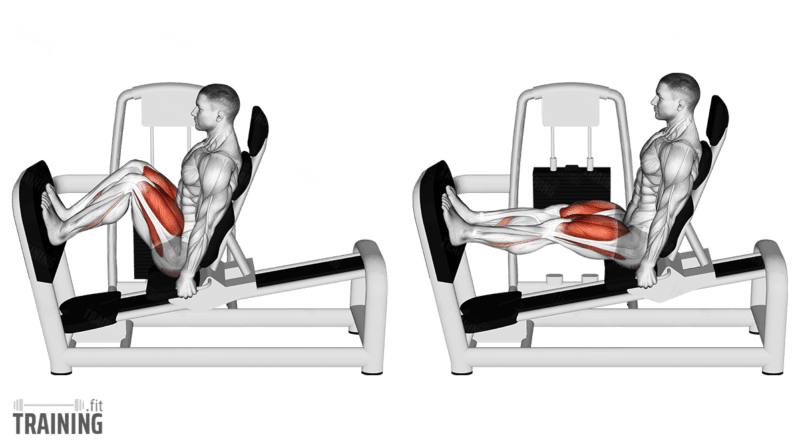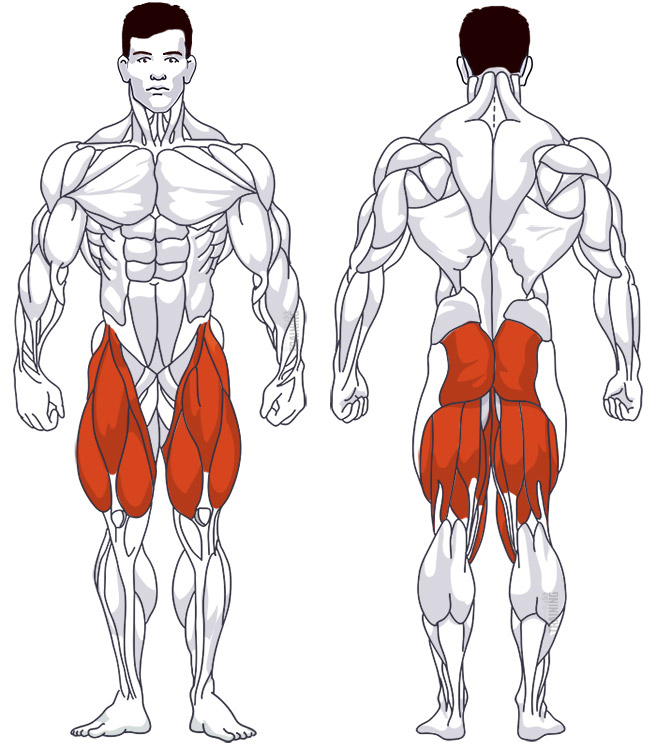Seated Leg Press
Isolation exercise, MachineOverview

Main muscles
- Thigh: Quadriceps
(Musculus quadriceps femoris) - Thigh: Thigh flexor
(Musculus biceps femoris) - Buttocks: Large gluteus maximus
(Musculus gluteus maximus)
Seated Leg Press: Basics and alternatives

Involved main muscle groups:
Seated Leg Press
The seated leg press is undoubtedly one of the most popular machine exercises out there. While sitting or lying on your back, you push the weight away from your body using a plate.
You’d be hard-pressed to find a gym without one. The reason is simple: The leg press effectively works your thighs, and it also involves your lower legs and buttocks.
Compared to squats (with the barbell), which have a very similar muscle focus, the stabilization effort is absent. As a result, the core and lower back are hardly utilized or not utilized at all during the leg press. This makes the execution of the leg press simple and safe.
An alternative to the machine can be Hack squats.
Correct Execution
As is often the case, you’ll find the leg press machine in various designs in different gyms. The machine can be oriented in a sitting or lying position. The lying variation basically always works the same way: you lie on your back at about a 45-degree angle and push the weight away from you with your legs.
The seated leg press can exist in two other variants: You sit relatively upright on the machine and push the leg plate, or move the seat by pushing against the leg plate. The pushing movement is parallel to the ground.
There’s no better or worse option here. All designs have the same muscle focus. In the following, the execution of the seated machine variant is described and shown in the video.
Adjusting your leg position allows for a little variation in muscle focus. If you place your feet a little higher up, the rear thigh (leg flexors) and the butt will be activated more. If the feet are a little further down on the plate, the focus is more on the front thigh (quadriceps).
Video Tutorial
Step-by-Step Instructions
Sit down on the seat.
Place your legs about hip-width apart on the footplate. Your feet should point upward in the same direction, and the soles should be firmly placed on the plate. The distance between the seat and the plate can usually be adjusted with a lever on the side of the seat. Choose the distance so that your lower and upper thighs form approximately a 90-degree angle.
Press your back firmly into the seat. Grab the handles next to the seat with your hands and stabilize your upper body.
Now push the weight with your legs. The pressure is applied through the rear part of the soles of your feet. Don’t fully extend your knees. The muscle tension should remain on your thighs throughout.
When bringing the weights down, make sure that the weight blocks don’t touch each other. If that’s the case, you can try selecting the next seat level that’s closer to the footrest. However, only do this if you can safely push the weight away from that closer position. Otherwise, maintain the previous distance and don’t bring your thighs too close to your upper body.
Common Mistakes
Leg position is crucial to ensuring you don’t develop knee joint problems. It’s important that both feet are about hip-width apart, parallel on the footplate. The tips of your feet should point in the same direction.
Also, make sure that the pressure on the footrest comes primarily from the rear part of your soles/heels. Don’t push the weight with your toes. The soles of your feet should remain firmly on the plate during the entire movement.
Your knees should also not be completely straight at the end of the extension motion. The muscle tension between the repetitions should be exclusively on your thighs – your knees should in no way relieve the muscles. This not only reduces the training effect but is also bad for the joints.
Additionally, don’t bend your legs too much. The angle between the upper and lower leg should be about 90 degrees. If you bend your legs further, the strain on the joints increases. The pressure in the abdomen then also increases, which could adversely affect a sportsman’s groin.
However, the reverse is also problematic: If you don’t bend your legs enough, the training stimulus is reduced. Therefore, make sure that you use the mentioned range of motion (approx. 90-degree angle).